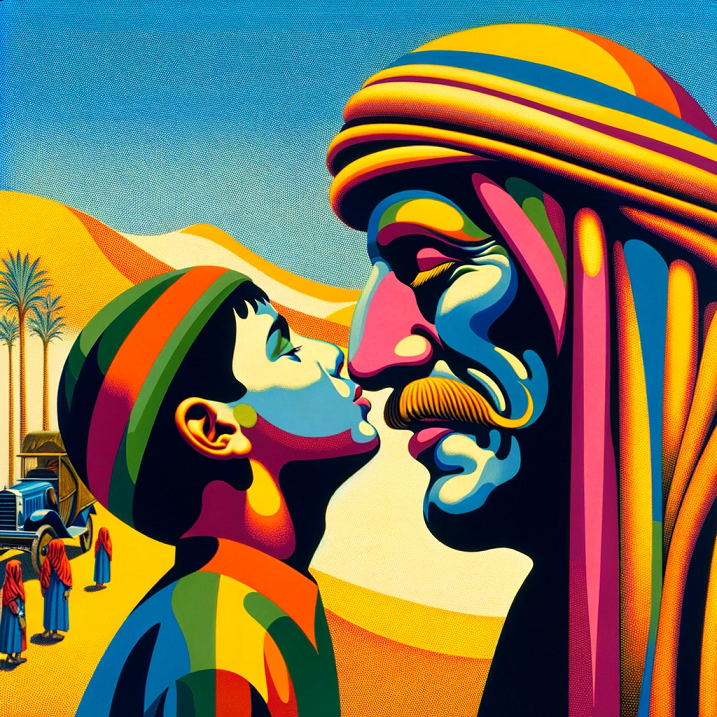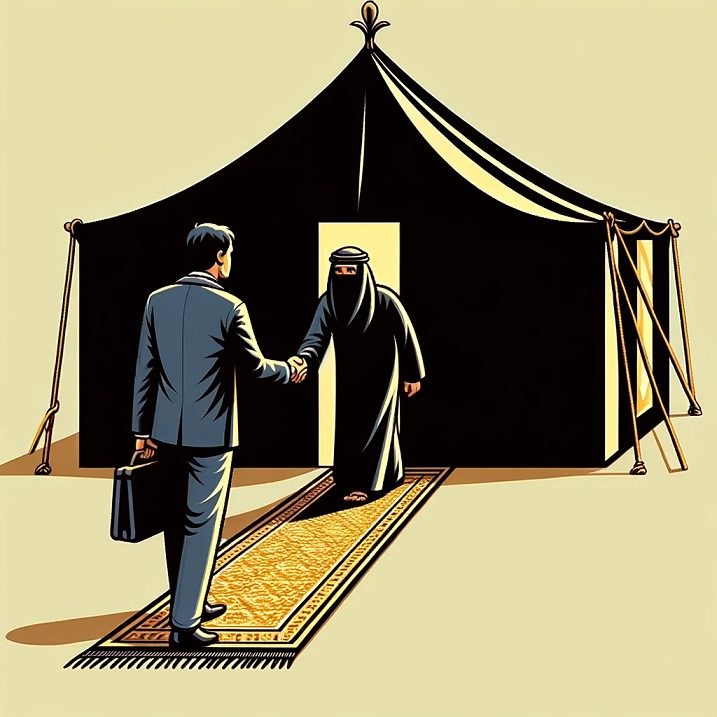“The Arab of the Desert,” authored by Harold Dickson, stands as a seminal work In the records of ethnographic literature, offering a vivid portrayal of the Bedouin Arabs’ life in and around Kuwait during the early 20th century. Dickson’s observations provide an invaluable window into a world that balances on the delicate scales of tradition and modernity.
- Arab greetings are more than pleasantries; they symbolize peace and trust.
- The ’Ikhwan movement significantly altered traditional Arab customs.
- Greetings among Arabs include a series of questions and answers, reflecting deep cultural roots.
- Physical gestures, especially kissing, are significant in Arab greetings.
- Gender-specific greetings show the nuances in male and female social interactions.
- In Kuwait and Arabia, it’s culturally inappropriate to greet superiors first in public.
- Children show utmost respect and modesty in greetings towards parents.
One significant aspect of Bedouin culture captured by Dickson – is the rich tapestry of Arab greetings and courtesy. These customs are imbued with profound cultural significance and serve as a microcosm of the broader social and moral fabric of Bedouin society.
The focus here is on dissecting and understanding the intricate layers of greetings and acts of courtesy, which, in Dickson’s portrayal, are not only modes of communication but also vessels of cultural identity, respect, and social cohesion.
The Essence of Arab Greetings
In “The Arab of the Desert,” Dickson intricately details the essence and diversity of greetings among the Bedouin Arabs, highlighting their profound significance in the social fabric. The traditional greeting “salam ’alaikum” (peace be upon you) and its response “’alaikum as salam” (on you be peace) are not mere exchanges of words but potent symbols of peace and trust. For the Bedouin, these greetings transcend the realm of customary pleasantries, equating to a tacit agreement of peace and mutual protection – akin to sharing salt or coffee in one’s tent.
Furthermore, Dickson elucidates the varied forms of greetings that are prevalent amongst the Bedouin. The common Bedouin greeting “al guwa,” meaning “Strength to you,” is a succinct yet powerful wish, embodying the community’s values of strength and resilience. The town’s version of the morning greeting, “subahkum ’illa bil khair,” offers a distinct contrast, showcasing the diversity within the Arab communities in their modes of expression.
Impact of Historical and Social Changes
Lt Col Dickson’s narrative poignantly captures the profound impact of historical and social changes on the traditional customs of Arab greetings and courtesy. The period between 1920 and 1930, marked by the rise of the ’Ikhwan movement, stands out as a significant epoch that witnessed a transformation of these age-old traditions. This movement, characterised by its fervent and fanatical approach, led to the erosion of some of the finest aspects of Arab customs, particularly those pertaining to hospitality and chivalrous conduct towards women.
However, Dickson also chronicles a period of revival and restoration of these customs, crediting H.M. King ’Abdul ’Aziz al Sa’ud for this cultural renaissance. Under his influence, the post-’Ikhwan era saw a gradual resurgence of the traditional practices that had once been the cornerstone of Arab social life. This revival, as Dickson observes, was a reaffirmation of the values and principles that these customs symbolised.
Yet, the responsibility for the initial decline of these customs is also attributed to King ’Abdul ’Aziz al Sa’ud, as he had inadvertently allowed the ’Ikhwan movement to gain momentum. Dickson’s account thus presents a nuanced view of this period, acknowledging both the cultural erosion caused by the ’Ikhwan movement and the subsequent efforts to revive the rich traditions that define Arab social interactions. These historical nuances are critical in understanding the dynamic and resilient nature of Bedouin culture, as it navigated through periods of upheaval and restoration.
Matters have once more taken a turn for the better, I am glad to say, and with the abatement of the more fanatical forms of ’Ikhwanism, that which is best and chivalrous in Arabia is slowly coming into its own again. The credit of this must be given to H.M. King ’Abdul ’Aziz al Sa’ud, though the responsibility for having allowed the ’Ikhwan to get out of hand in the first place must forever lie at his door.
H.R.P Dickson The Arab of the Desert
Formalities and Nuances in Greetings
Dickson’s exploration into the Arab greetings extends beyond their initial exchange, revealing a complex array of formalities and nuances that follow. These greetings, particularly among the Bedouin Arabs, evolve into a series of questions and answers, each carrying its own cultural significance and decorum. This ritualistic exchange is not merely about inquiring into one’s well-being but is a structured form of social interaction, deeply rooted in the culture.

The greetings often involve a sequence of inquiries such as “shlun kum?” (How are you?) or “kaif halak, kaif hal?” (How are you, how goes it?), with each question warranting a proper and expected response. These questions and answers are fired off in quick succession, reflecting a rhythm and pattern that is characteristic of Arab social etiquette. This form of greeting is not only a way to express concern and maintain social ties but also serves as a medium to reinforce communal bonds.
Two friends meeting in the desert or in the city will hold hands and start firing off a whole string of various forms of salutation at each other, and until they have finished will continue to clasp hands. It is quite amusing for a European to watch this very formal and apparently meaningless method of saying “How do you do ?”
H.R.P Dickson The Arab of the Desert
The cultural importance of these exchanges is further exemplified in their adaptability and specificity to various contexts. For instance, the greetings used among close relations or friends returning from a journey differ significantly from those used in everyday encounters. These variations reflect the sensitivity and attention to detail that the Arab culture bestows upon the act of greeting.
Physical Gestures in Greetings
In his detailed account, Dickson also sheds light on the physical aspect of greetings among the Bedouin Arabs, which are as significant as the verbal expressions. The physical gesture of kissing, either on the nose or both cheeks, is a common and culturally significant form of greeting, especially among close relations or when greeting a person of higher status, like a sheikh. This gesture is deeply rooted in the Bedouin tradition and is regarded as a sign of respect and affection.
The choice of whether to kiss the nose or the cheeks, and the decision of which one to opt for, is imbued with cultural subtleties. The nose kiss, often considered more intimate and respectful, is commonly used, especially in greetings with a sheikh or a respected elder. Dickson himself recounts his experiences of being greeted with such warmth and respect, reflecting the deep-seated traditions of Arab hospitality and reverence.
The Badawin will always follow his salam ’alaikum with a kiss on the nose, or a kiss on both cheeks, the one on the nose being the most common. I have often been much embarrassed with this form of attention from half a dozen men at a time.
H.R.P Dickson The Arab of the Desert
Moreover, these physical gestures extend beyond men’s greetings. For example, a Bedouin man meeting a close female relative, such as a sister or the wife of a great friend, in the desert would greet her with a kiss on the head or cheek, though always maintaining the decorum expected in public interactions. This act is a delicate balance between affection and respect for social norms, encapsulating the intricate nuances of Bedouin culture.
Gender-Specific Greetings
Dickson’s thorough documentation of Bedouin Arab culture reveals insightful distinctions in gender-specific greetings and conversational norms. In his observations, it is apparent that while the foundational greeting of “salam ’alaikum” remains universal, the subsequent interactions display notable variations based on gender.
Among men, the greeting exchanges are typically brief and focused more on general well-being and external matters. These exchanges often avoid personal or familial inquiries, particularly concerning female family members, unless the men share a close bond. Such restraint reflects the cultural norms of privacy and respect that govern male interactions.
In contrast, greetings among women are characterised by a deeper level of personal inquiry. Women frequently engage in extended conversations about family health and well-being, delving into details about husbands, children, and even inquiring about other wives in polygamous households. This level of detail in conversation is permissible and expected among women, illustrating the close-knit nature of female social networks within the Bedouin community.
Greeting Etiquette in Kuwait and Arabia
In “The Arab of the Desert,” Dickson provides a detailed comparison of greeting etiquette in Kuwait and the broader Arabian context, revealing subtle yet significant cultural nuances. One key aspect he notes is the etiquette surrounding public greetings and the manner in which individuals acknowledge superiors or elders. Contrary to the practices observed in India, where the lower social strata are expected to initiate greetings, in Kuwait and Arabia, it is considered inappropriate for a man to rise and greet a superior in the street. This practice is viewed as an attempt to draw attention to oneself, which is frowned upon in Bedouin culture.
Instead, Dickson points out that the accepted norm is for the ‘big man‘, or the superior, to offer the greeting first. This could be a person of higher social standing, a man walking to a sitting person, or a horseman to a pedestrian. Only after the superior has initiated the greeting is it polite for the other party to return the ‘alaikum as salam’. Dickson interprets this custom as having roots in the Qur’anic teachings, highlighting its religious and cultural significance.
Furthermore, in the realm of family greetings, there is a distinct protocol observed between parents and children. Children are expected to show utmost respect and modesty when addressing their parents, especially in public. The use of specific terms like ‘al Walid’ (the Begetter) instead of a more casual reference underscores the reverence for familial roles and the emphasis on maintaining a formal and respectful tone in family interactions.

A son does not greet his father as he would another man. He must show proper modesty, and especially amongst strangers must take a back seat and appear to obliterate himself in the presence of his parent. A son must always refer to his father as al Walid (the Begetter), not Aboui (my father). The latter is a town expression with a Christian tang about it, and is therefore despised by the Badawin.
H.R.P Dickson The Arab of the Desert
In conclusion, Dickson’s comprehensive study of Arab greetings and courtesy offers a window into the soul of the Bedouin Arab community. It encapsulates the essence of their social interactions, showing how these practices are intertwined with the very fabric of their identity. As we reflect on Dickson’s work, we gain not only an understanding of a particular aspect of Arab culture but also an appreciation for the complexities and richness of human social practices across different cultures.
Q: What do Arab greetings symbolize?
A: They symbolize peace and trust.
Q: How did the ’Ikhwan movement affect Arab customs?
A: It significantly altered traditional Arab customs.
Q: Who was responsible for reviving traditional Arab customs?
A: H.M. King ’Abdul ’Aziz al Sa’ud.
Q: What is unique about Arab greeting exchanges?
A: They include a series of questions and answers, reflecting deep cultural roots.
Q: How important are physical gestures in Arab greetings?
A: Very important, especially gestures like kissing.
Q: Are there differences in greetings based on gender in Arab culture?
A: Yes, there are nuanced differences in male and female social interactions.
Q: What is the greeting etiquette towards superiors in Kuwait and Arabia?
A: It’s culturally inappropriate to greet superiors first in public.
Q: How do children greet their parents in Arab culture?
A: With utmost respect and modesty.
Q: What overall cultural aspect does Dickson’s work illuminate?
A: Dickson’s work provides a comprehensive understanding of Bedouin culture and social practices.

